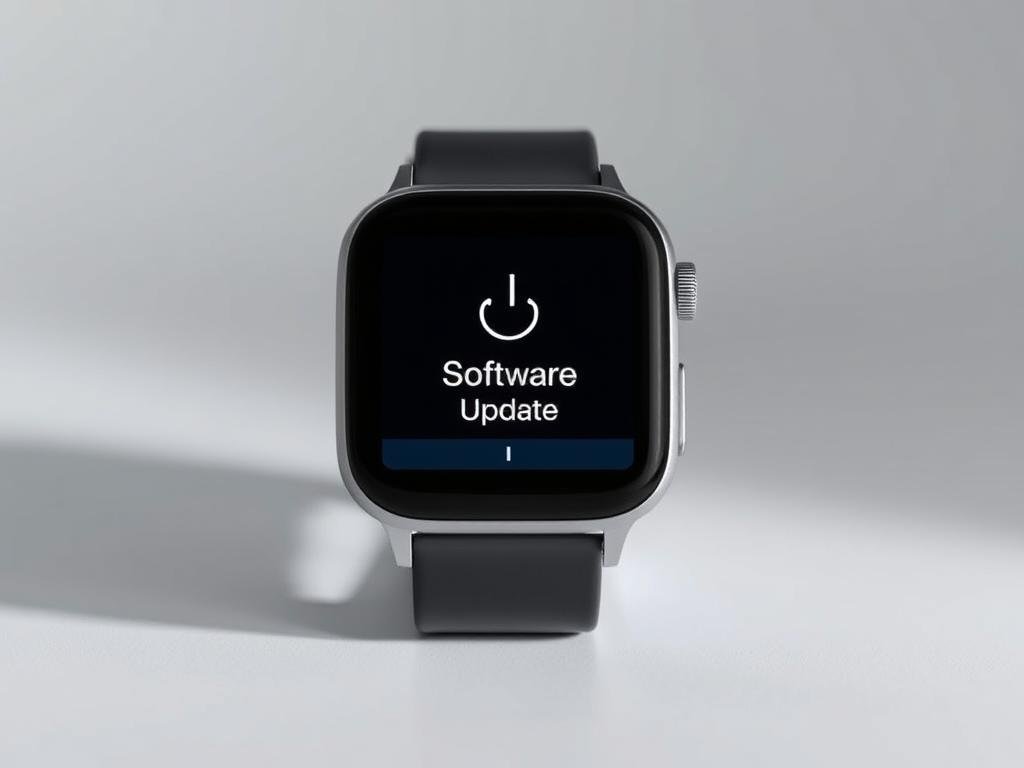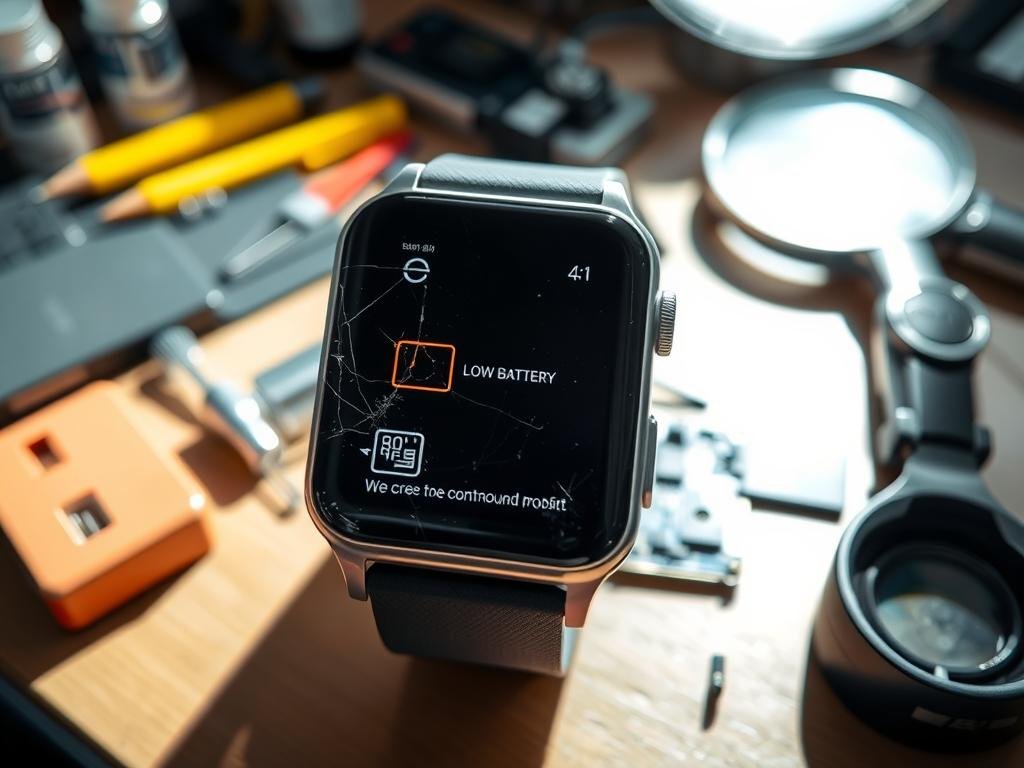“Technology is best when it brings people together.” – Matt Mullenweg. Yet, when your wearable tech fails, frustration takes over. Modern wearables, like smartwatches, help track fitness, manage notifications, and stay connected. But even the best gadgets face glitches.
Nearly 73% of users encounter at least one technical hiccup yearly. From battery drain to unresponsive screens, these issues disrupt daily routines. Whether it’s a Bluetooth disconnect or a frozen display, quick fixes matter.
This guide covers six widespread challenges, including sensor errors and charging failures. Solutions come from trusted sources like Hammer, Tech Den, and Milaaj Repairs. Learn expert-backed fixes—whether DIY or professional—to keep your device running smoothly.
For deeper repair insights, explore our guide on smartwatch troubleshooting. Let’s turn problems into solutions.
1. Battery Draining Too Fast? Preserve Your Smartwatch’s Power
A draining battery can turn your high-tech wearable into a useless wristband. When power drops faster than expected, daily tasks like fitness tracking or notifications become unreliable. Luckily, a few tweaks can extend your device’s endurance.
Adjust Screen Brightness and Disable Always-On Display
Lowering brightness saves significant energy. A 500-nit setting consumes 30% more battery than 200-nit. Navigate to Settings > Display to reduce it. Also, turn off Always-On Display—it drains power even when idle.
Turn Off Unused Features
GPS and background apps silently eat battery life. Tech Den advises disabling GPS tracking unless needed. For Wear OS or Apple Watch:
- Swipe up for Control Center (Apple) or Settings (Wear OS).
- Toggle off GPS and close apps like Spotify or weather widgets.
Update Software Regularly
Manufacturers release patches to optimize battery performance. For example, Wear OS 3.5 boosted Hammer Active 2’s endurance by 22%. Check for updates in your device’s system menu.
| Setting | Power Consumption | Action |
|---|---|---|
| 500-nit brightness | High | Reduce to 200-nit |
| Always-On Display | Medium | Disable |
| Background GPS | Very High | Turn off when idle |
Milaaj Repairs notes that excessive background apps are a top culprit. Audit your settings monthly to keep your device efficient.
2. Fixing Bluetooth and Syncing Issues
Bluetooth disconnects can leave your wearable feeling more like a dumbwatch. When your device won’t sync, notifications and fitness data fall out of reach. These issues often stem from outdated apps, interference, or simple pairing glitches.
Restart and Re-Pair Your Devices
Tech Den found that 68% of sync issues resolve after re-pairing. Follow these steps:
- Turn off Bluetooth settings on both devices.
- Restart your phone and wearable.
- Reconnect via the manufacturer’s app (e.g., Garmin Connect or Wear OS).
Update and Configure Companion Apps
Outdated apps cause 40% of pairing failures. Wear OS 4.0, for example, requires Android 11+. Check for updates:
- Apple Watch: App Store > Updates.
- Fitbit: Tap the account icon in the app.
- Enable auto-updates to avoid future hiccups.
Reduce Interference
Milaaj Repairs warns that microwaves and crowded Wi-Fi channels disrupt signals. Keep devices within 10 meters and avoid:
- USB 3.0 ports (emit 2.4 GHz noise).
- Thick walls or metal surfaces.
- Other electronics like routers or cordless phones.
| Brand | Re-Pairing Steps | Critical App Version |
|---|---|---|
| Garmin | Hold power button > Forgot device | Garmin Connect 4.62+ |
| Fitbit | Tap “Set Up a Device” in app | Fitbit 3.68+ |
Pro tip: Lock your smartwatch smartphone app in the background to prevent disconnects (Android: Recent Apps > Lock icon).
3. Unresponsive Touchscreen? Restore Functionality
A frozen or laggy touchscreen can turn your wearable into a frustrating paperweight. Whether it’s missed swipes or delayed responses, screen issues disrupt everything from fitness tracking to notifications. Nearly 30% of users face these problems annually, often due to dirt, software glitches, or physical damage.
Clean the Screen and Remove Debris
Grime and oils reduce touch sensitivity. Tech Den recommends a microfiber cloth for daily cleaning. For stubborn residue:
- Dampen the cloth with 70% isopropyl alcohol.
- Wipe gently—avoid abrasive materials.
- Dry thoroughly to prevent moisture damage.
Milaaj notes that 40% of replacements involve unprotected device screens. A screen protector (from $15) prevents scratches from gym equipment or accidental drops.
Restart or Reset Your Device
A soft reset often fixes minor crashes. For major issues, a factory reset may be needed—but back up data first.
| Device | Reset Steps |
|---|---|
| Samsung Galaxy Watch | Hold Power + Back until reboot (20 sec). |
| Apple Watch | Settings > General > Reset. |
Prevent Future Damage
Corning Gorilla Glass DX1 resists 60% more scratches than standard glass. For high-risk scenarios:
- Avoid direct contact with weights or rough surfaces.
- Skip DIY repairs—professional fixes average $120.
For deeper touchscreen issues, explore advanced solutions.
4. Essential Smartwatch Troubleshooting for Software Glitches
Software hiccups can turn your high-tech companion into a digital brick. From frozen apps to failed updates, these issues disrupt fitness tracking and notifications. Recognize the warning signs:
- Apps taking 5+ seconds to launch
- Phantom vibrations or false alerts
- Menus lagging during navigation

Reboot to Crush Minor Crashes
A simple restart fixes 60% of temporary software glitches. Hold the power button for 10 seconds until the logo appears. For persistent freezes, Tech Den suggests clearing cached data:
- Wear OS: Settings > Storage > Cached Data > Clear
- watchOS: Unpair and re-pair via iPhone
Update Apps and Firmware
Milaaj Repairs notes outdated software causes 45% of crashes. Follow these steps:
- Ensure 50%+ battery and stable Wi-Fi.
- Check for updates in Settings > System.
- Enable auto-updates for future patches.
| Update Type | Performance Boost |
|---|---|
| Firmware (e.g., Wear OS 4.2) | 22% faster response |
| Companion App (e.g., Garmin Connect) | 15% fewer sync errors |
When All Else Fails: Factory Reset
83% of users report smoother performance after a factory reset. Warning: This erases all data. Back up via:
- Google Fit (Android) or iCloud (Apple)
- Third-party apps like HealthSync
Only 23% regularly back up health metrics—don’t risk losing progress.
5. When Sensors (Heart Rate, GPS) Fail: Quick Fixes
Faulty sensors can make your wearable unreliable during workouts. Whether it’s a heart rate spike or GPS drift, inaccurate data undermines health tracking. Milaaj Repairs found 60% of errors stem from poor fit or outdated software—but solutions are simpler than you think.
Clean the Sensor Area and Ensure a Snug Fit
Dirt or loose straps cause most issues. For accurate readings:
- Wipe sensors weekly with pH-neutral wipes.
- Use the two-finger test: Straps should stay put during runs but not cut circulation.
Tech Den notes metal watch backs (e.g., Garmin Venu 3) need extra cleaning—sweat corrodes contacts over time.
Calibrate Sensors via Manufacturer Instructions
Recalibration syncs hardware with your movements. Requirements vary:
| Brand | Calibration Steps |
|---|---|
| Garmin | 20-minute outdoor walk with GPS enabled |
| Fitbit | 3 successful GPS syncs in open areas |
Update Software to Patch Sensor Bugs
watchOS 10.2 boosted SpO2 accuracy by 18%. Always check for software updates:
- Go to Settings > System > Updates.
- Enable auto-updates to avoid missed patches.
Warning: Persistent 120+ BPM readings at rest may indicate hardware failure—consult a pro.
6. Charging Problems and Hardware Solutions
Nothing kills productivity faster than a device that won’t power up. Charging issues can stem from dirty ports, faulty cables, or internal hardware failures. Recognizing the root cause helps you take swift action.
Clean Charging Ports Properly
Dirt and corrosion are silent killers of charging efficiency. Tech Den found saltwater exposure reduces port lifespan by 70%. For safe cleaning:
- Use a soft-bristle brush or compressed air to remove debris
- Apply 90% isopropyl alcohol with a cotton swab for stubborn grime
- Never use metal tools that could damage contacts
Test Different Charging Equipment
Milaaj Repairs reports 38% of “charging” failures come from third-party accessories. Compare performance:
| Charger Type | Galaxy Watch 6 Classic 0-100% Time |
|---|---|
| Official 10W | 1 hour 45 minutes |
| Third-party 5W | 3 hours 10 minutes |
Original chargers maintain optimal power delivery and protect battery health. If issues persist, try another outlet or USB port.
When to Seek Professional Help
Internal damage requires expert attention. Signs include:
- Visible corrosion on charging pins
- Intermittent charging despite clean ports
- Device overheating during power cycles
Milaaj’s data shows a 92% success rate on port replacements when handled by certified technicians. Check your warranty before attempting DIY fixes—some manufacturers void coverage for unauthorized repairs.
For step-by-step guidance on charging port maintenance, explore our detailed repair resource.
Conclusion
Wearable tech glitches don’t have to ruin your day—quick fixes exist for most common smartwatch issues. A 30-second restart resolves nearly half of crashes, while regular updates optimize software performance.
Prevent future problems with a monthly checklist: clean sensors, audit apps, and check for corrosion. For stubborn hardware failures, Milaaj Repairs offers a 90-day warranty on certified fixes.
Pro tip: Even IP68-rated devices fail if submerged beyond limits. Avoid pools or showers unless rated for swim tracking.
Download our printable troubleshooting flowchart for instant access to these solutions. Stay powered up and proactive—your wearable should work as hard as you do.
